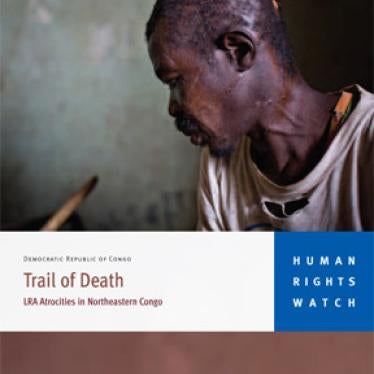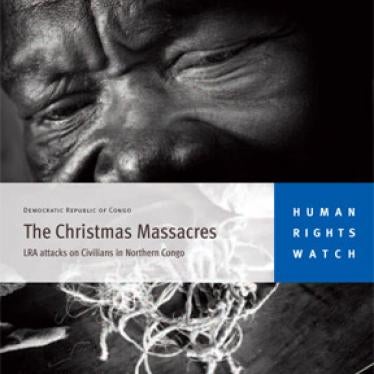(New York) - Combatants of the rebel Lord's Resistance Army (LRA) brutally massacred at least 620 civilians and abducted more than 160 children between December 24 and January 13 in northern Democratic Republic of Congo, said Human Rights Watch and Justice Plus, a Congolese human rights organization. Many of the victims were killed or abducted in three simultaneous attacks on December 24 and 25, 2008.
In a two-week mission to the region, Human Rights Watch and Justice Plus researchers collected detailed information, including lists of persons killed or abducted in and around Doruma, Faradje and Duru, in Haute Uele territory. At several sites where the killings took place, researchers found fresh graves, pools of dried blood, cords used to tie up prisoners and blood-stained bats and axes used to kill the victims.
"The LRA went in intending to kill and they left few survivors," said Anneke Van Woudenberg, senior researcher at Human Rights Watch. "The similar tactics and the near-simultaneous attacks indicate this was a planned operation meant to slaughter and terrorize as many civilians as possible."
The LRA attacks followed the beginning of a joint military operation on December 14, led by the Ugandan army with support from the Congolese, Southern Sudanese, and Central African Republic armies. The Ugandan army attacked the LRA headquarters in Congo's Garamba National Park, near the border with Sudan.
Following the attack, the LRA dispersed into several groups, each of which targeted civilians along its path. The rebels waited until December 24 for the most devastating of their attacks, waiting until people had come together for Christmas festivities, then surrounding and killing them by crushing their skulls with axes, machetes, and large wooden bats. Most of the few who survived also had head wounds, but two 3-year-old girls had serious neck injuries, suffered when LRA combatants tried to twist off their heads.
In the village of Batande, three miles from Doruma, near the Sudanese border, the LRA killed at least 80 people on December 25 when village residents had gathered for Christmas lunch after the morning church service. LRA members surrounded the people, tied them up with rope or rubber strips from bicycle tires, and then separated the men and boys from the women and girls. They took the men and boys about 40 meters from the church and killed them immediately with blows to the head. They took the women and girls into the forest in small groups and raped many of them before crushing their skulls.
One of the few survivors in the village, a 72-year-old man who arrived late for Christmas lunch, hid in the bushes and watched in horror as his wife, his children and grandchildren were killed. He later buried many of the bodies and told Human Rights Watch researchers that only six people had been left alive in the village.
When the killing ended in Batande, the LRA combatants ate the Christmas feast the villagers had prepared, and then slept among the dead bodies before continuing on their trail of destruction and death. LRA combatants attacked another 12 villages on December 26, 27, and 28.
In Faradje, a town to the east of Garamba National Park and about 150 miles from Doruma, another group of LRA combatants also attacked on Christmas Day, killing at least 143 people and abducting 160 children. The tactics were similar, with the LRA combatants crushing their victim's skulls with axes and bats. The dead included the local doctor, two school inspectors, teachers, two pastors, and state officials.
As their operations continued into the night, the LRA set fire to about 940 houses, three primary schools and nine churches. They left early in the morning with the abducted children and 20 adults, all of whom were tied up together and forced to carry goods looted by the assailants.
The LRA attacks are continuing. According to eyewitnesses interviewed by Human Rights Watch, LRA combatants killed at least 86 people between January 8 and 11 in Sambia, Akua, and Tomate towns, to the south of Faradje. Given that information from these attacks is still incomplete, it is likely that the death toll is much higher.
"Hundreds of people have been slaughtered and this just goes on," said Joel Bisubu, of Justice Plus. "We need food and medical supplies for the injured, but even more we need protection."
Soldiers of the joint military operation have provided limited protection to people of the region. The Ugandan army says its objectives are to track the LRA and its leader, Joseph Kony, wanted on an arrest warrant from the International Criminal Court (ICC), and to rescue civilians abducted by the LRA. To date, Ugandan troops have rescued 25 people.
Congolese army soldiers arrived in Doruma and Faradje only after the massacres had taken place.
The United Nations Mission in Congo, MONUC, has a mandate to protect civilians and provides logistical support to the Congolese army, but is not part of this operation. Most of the UN peacekeepers are posted farther south in eastern Congo, where other rebel forces and the Congolese army have been fighting a war that has also taken a devastating toll on civilians.
LRA leaders, including Kony, are wanted by the ICC for war crimes and crimes against humanity committed in northern Uganda. Any ICC suspects who are captured or surrendered should be turned over for trial at the ICC immediately, Human Rights Watch said. Uganda and DRC are both ICC state parties obligated to cooperate with the court, including by assisting in executing ICC warrants.
"In the past, Ugandan army attacks on the LRA have often spurred immediate reprisals on civilians living nearby," said Van Woudenberg. "LRA atrocities like these show the Ugandan army needs to take steps to protect civilians when undertaking offensive military operations."






